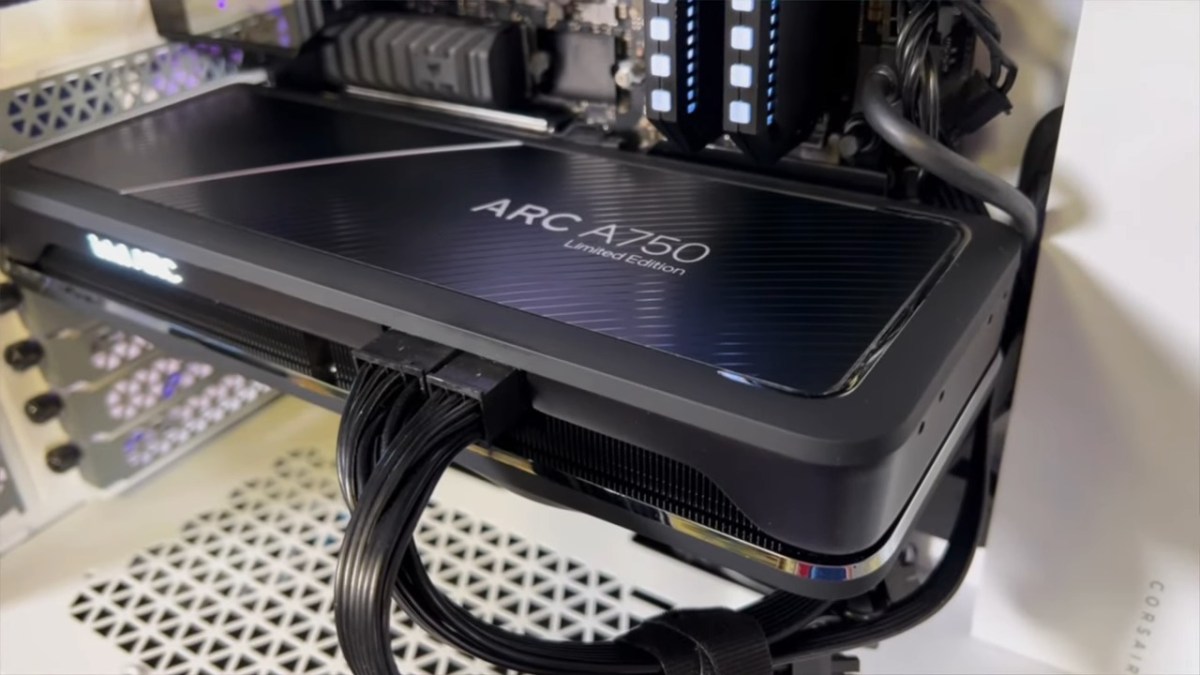Intel just released a short showcase that went over the general features of the Arc A750 graphics card. To be specific, Intel showed off the Limited Edition of the Arc A750, which will come packaged with HDMI 2.1 support out of the box. The showcase didn’t really focus on framerates and other gaming performance metrics, but we have a decent amount of information to dive into here.
This Intel Arc A750 showcase, presented by Ryan Shrout, covers the graphics card in a very broad way. Don’t expect to see any of the in-depth details such as specs just yet. For the most part, it covers the Arc A750’s support for HDMI 2.1, VRR, and HDR. It also gives us a look at the graphics card plugged into an actual PC, giving us a good look at its size in practice. All in all, there’s a mixture of things both great and disappointing in this presentation. But since it covers the card in such a general way, we can’t get into the nitty-gritty details.
Testing the Arc A750 with Death Stranding
To start things off, let’s cover the demoed gaming performance. Just note that this presentation only lightly touched on this aspect, since a more in-depth performance showcase occurred earlier in July. The game Intel used in the presentation was Death Stranding: Directors Cut, which isn’t a title that’s used in many benchmarks. It’s not exactly a demanding game most of the time, with largely static backgrounds and mostly barren environments covering the world.
Shrout played the game on an Acer display that supports 4K, 120Hz, and Variable Refresh Rate (VRR). The game wasn’t running at 4K though. Instead, Intel opted for 1440p. The video also didn’t go into which graphics settings were applied. This makes it hard to say where the Arc A750 falls in terms of performance.
The Arc A750 was able to run Death Stranding at around 90fps, with dips to 80 and highs of 100. Broadly speaking, this puts the Arc A750 on par with cards like Nvidia’s RTX 3060, or AMD’s RX 5700 XT.
Again, we’re missing a lot of information here to decisively pit it against other cards. But going off this video alone, it seems to handle Death Stranding pretty well. But this wasn’t something the showcase spent a great deal of time on. Instead, it covered things like HDMI 2.1 support for Intel’s Arc A750 in greater detail.
HDMI 2.1, VRR, and HDR support
Intel’s focus for this showcase was on covering the general features of the graphics card. The first of the bunch was HDMI 2.1 support, and it’s not cut and dry. HDMI 2.1 is indeed supported right out of the box by the Arc A750. However, this support is not native and requires an additional PCON chip to convert DisplayPort 2.0 to HDMI 2.1.
Shrout confirmed that the decision to include this chip will be left to partners that want to support it. The Intel Limited Edition version of the Arc A750 graphics card will have it though.
The other features are straightforward. The Arc A750 supports monitors with VESA Adaptive Sync, so VRR is there. Intel will also validate more than 100 of the top-selling VRR displays to ensure compatibility with Arc.
As for HDR support, that’s hard to discern in a YouTube video. A different monitor was used to test the Arc A750’s HDR capability. Intel used an Alienware QD OLED display in testing Death Stranding. The company claims the feature works fine, but independent verification will be necessary.
A fairly broad showcase
Ultimately, the showcase didn’t present Intel’s Arc A750 in great detail. In terms of its features, it seems to be about on par with Nvidia and AMD’s mid-range options. But again, since this demo glossed over plenty of the details, it’s hard to say where it falls. We’ll have to wait for the Arc A750 to release before any in-depth coverage on these graphics cards can be presented. At the moment, there’s no exact word on when we may see these cards hit store shelves. With any luck, Intel will hopefully iron out more issues and the release Arc with time to spare before Nvidia’s RTX 40 Series and AMD’s RX 7000 Series arrive.









Published: Jul 28, 2022 6:15 PM UTC